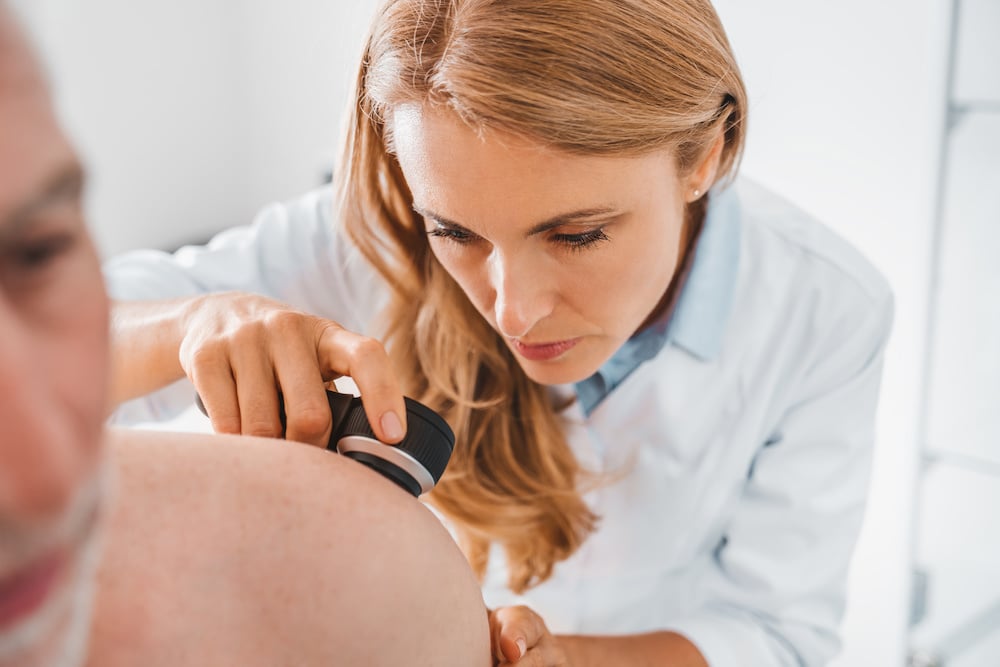
Skin cancer is the most common type of cancer in the United States. Many people don’t realize there is more than one type of skin cancer. The two broad categories of skin cancer are melanoma and nonmelanoma. Melanoma is the most invasive type of skin cancer. It can spread rapidly to other organs of the body. Nonmelanoma skin cancers, on the other hand, are less likely to spread to other areas of the body.
To ensure healthy skin, watch for any new, suspicious-looking spots and take steps to protect your skin from the sun. Your primary care doctor or a dermatologist can also perform a skin check. They will test any areas on the skin that appear to need further treatment.
In addition to being aware of changes in your skin, understanding more about how skin cancer develops and is treated is helpful for anyone who spends time in the sun.
7 Skin Cancer Facts That Might Surprise You
It’s important to understand what skin cancer is and what symptoms can appear, as this will help you protect yourself and lower the risk of developing this disease.
1. UV Radiation Alters Your DNA
There is one common factor among all types of skin cancer: exposure to ultraviolet (UV) light can damage DNA and increase your risk of developing skin cancer. UV radiation can come from sunlight or artificial lights, such as tanning beds. Protect your skin from direct UV light by using sunscreen and covering up when possible. Avoid tanning beds.
2. Treatment for Skin Cancer is Necessary
If you receive a skin cancer diagnosis, the primary treatment is typically surgery. For small areas on the skin, an in-office biopsy may be enough to remove the cancerous cells. If you have melanoma or a nonmelanoma that is large or deep, you may need a separate surgery and additional treatments, such as radiation therapy, chemotherapy, or immunotherapy. This will make sure any remaining cancer cells are destroyed and lower the likelihood they will return.
It’s a good idea to speak with an oncologist if your dermatologist feels that additional treatment is needed. The oncologist and dermatologist will discuss your specific situation, including the type of skin cancer and stage, to determine which treatments would be most beneficial.
3. Sunscreen May Not Be Enough to Lower Your Skin Cancer Risk
Shielding your skin from harmful UV rays is the number one way to lower your risk of developing skin cancer. While sunscreen plays an important role in protecting your skin, it may not be enough, especially if you have fair skin, light hair, and/or light eyes. However, even those with a darker complexion are still at risk and should take precautions to protect their skin. Try to avoid the peak hours of the sun. Wear sunscreen and apply it to all exposed skin, even to the areas you may not think of, such as the top of your ears, your hairline, and the top of your hands. Be sure you also wear a hat and sunglasses to protect your scalp, eyes, and face.
4. Using Tanning Beds Increases Skin Cancer Risk
Damage to your skin from UV light exposure builds up over time, whether it’s from the sun or from tanning beds. In fact, the use of tanning beds increases your likelihood of developing the two most common types of nonmelanoma skin cancer — squamous cell carcinoma by 58% and basal cell carcinoma by 24%. Many tanning bed users are young, so it's important to note that using tanning beds before the age of 20 increases your melanoma risk by 47%. Each time you use a tanning bed, your risk of developing skin cancer goes up.
Consider using a spray tan or other sunless tanning products for a deeper tan. And remember, sunless tanning products do not contain UV protection. Use sunscreen and protect your skin and head with clothing, hats, and sunglasses.
5. You Can Get a Sunburn on Cloudy Days
You should wear sunscreen every day, regardless of whether you're spending the day at the beach or working indoors. Even if it's cloudy, UV rays can still penetrate the clouds and reach your skin. It can even come through the car window, especially in the summers when the sun is more intense. Reapply sunscreen every few hours. Don’t forget the tops of your hands if you’re going to drive for a while.
6. Certain Medications Can Increase Skin Sensitivity to the Sun
Certain medications can cause sensitivity to the sun, which increases the risk of sunburn. Each sunburn increases your risk of skin cancer, especially melanoma. Talk with your doctor to find out if there are other medication options or if the time of day you take your medicine can lower your risk of sunburn.
If you cannot change your medications, try to stay in the shade when outside, and wear sunscreen on any exposed skin, including your face, scalp, and lips.
7. Skin Cancer Can Appear in Unexpected Areas
Skin cancer is more likely to appear on your face than on other parts of your body. Melanoma, in particular, often develops in areas that are exposed to UV light, such as your head, neck, and ears. However, melanoma can also appear in areas you would not expect, such as the bottoms of your feet or areas covered by a bathing suit.
Make sure to regularly check your entire body for signs of skin cancer. Track changes in an app or take notes so you can compare your skin over several months. If you are tracking an area that seems to be changing, or if you notice an unusual spot appears suddenly, it’s a good idea to have it checked right away by a dermatologist. In addition, because you can’t see all of your skin, it's a good idea to schedule an annual exam with a dermatologist for a skin cancer check.
What to Expect if You Need Additional Skin Cancer Treatments
Some skin cancer patients receive topical chemotherapy to kill cancer cells. Others may receive radiation therapy as part of their skin cancer treatment plan. A radiation oncologist will oversee the treatment planning process.
External beam radiation therapy is the most common type of radiation therapy for skin cancer. Most patients receive a few rounds of treatment over the course of a few weeks. The amount of radiation will depend on how large and how deep the cancer grew into the skin before it was removed.
At Radiotherapy Clinics of Georgia, the radiation oncologists typically use an advanced form of external beam radiation treatment known as intensity-modulated radiation therapy (IMRT) that will deliver the beams at the precise shape of the area being treated.
Skin Cancer Treatment from Radiation Oncologists in the Greater Atlanta Area
If you or a loved one has received a skin cancer diagnosis with radiation therapy as part of the treatment plan, the oncologists at Radiotherapy Clinics of Georgia are available in locations throughout the Atlanta area. It’s helpful to choose a cancer center close to home since most patients receive daily radiation treatments for a few weeks. Our cancer treatment centers are conveniently located in Conyers, Covington, Decatur, and Snellville, Georgia.


